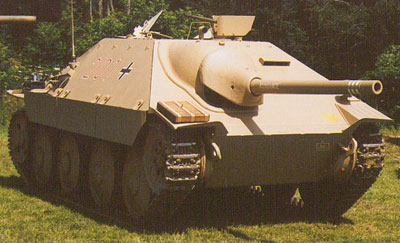
Logo from Scott Cunningham.

Logo from Scott Cunningham.
![]() he method of assembling armour can significantly affect its ability to withstand attack. Assembly techniques includes the method chosen to secure armour plate together, the number of joins between armour plate, and also the presence of ports, cut-outs and holes in the armour for such things as vision slits.
he method of assembling armour can significantly affect its ability to withstand attack. Assembly techniques includes the method chosen to secure armour plate together, the number of joins between armour plate, and also the presence of ports, cut-outs and holes in the armour for such things as vision slits.
There are two main methods of securing the parts of the vehicle together: by using fasteners such as rivets, and by welding. Riveting was common for early armoured vehicles because welding large, thick plates was a skill in short supply. It was also time consuming and could ruin the heat treatment of armour plate if carried out incorrectly. In contrast riveting was relatively easy to carry out with unskilled labour and provids an equally strong join.

A British Valentine (restored to nearly Mk.IX standard) showing riveted construction. The rivet heads are the small rounded bumps on the surfaces and edges of the armour plate. From Armour in Focus.
The drawback of riveted armour became apparent in combat. When riveted armour is hit by a projectile the rivet heads tend to shear off and fly around the interior of the tank causing damage to the interior of the vehicle and injury to the occupants. This occurs even if the projectile is not powerful enough to penetrate the armour. Welded armour is better because it does not suffer this extra damage when hit by a non-penetrating projectile.
Too many joins in an armour plate can greatly weaken it. For example, early Sherman M4A2s and M4A3s had seven and five different pieces of RHA plate, respectively, joined together by welds to make up the hull front. These many joins excessively weakened a critical piece of armour and failed even when not directly hit but as a result of the impact shock on an adjoining piece of armour. Sherman ultimate design M4A2s and M4A3s produced from early 1944 had a one piece hull front armour which eliminated this weakness.5

A late war German Jagd.Pz.38(t) Hetzer showing clean lines and uncluttered construction. Compare this to the early war British vehicle above. From Armour in Focus.
Armour is also weakened by having ports and holes cut out of the plate. Often such cut-outs are unavoidable, being required for vision slits, secondary weapons, escape hatches, etc. Each such cut-out reduces the effectiveness of the armour plate, compared to one of equal thickness with no cut-outs. As the war progressed tank design improved by reducing the need for such cut-outs. As a result later armoured vehicles have a much cleaner look compared to the clutter of earlier designs.
An interesting characteristic of later German armoured vehicles is the use of an interlocking join for armour plate at each corner. Machining such joins from thick armour plate (as much as 250mm thick) would be time consuming, but they obviously considered it worthwhile.
Do you like this web site? Please rate it between one and ten, with ten being the best:
Ratings are submitted to: The Wargames and Military History Search Engine.
Copyright © 2000 David Michael Honner. E-mail: GvA@wargamer.org.